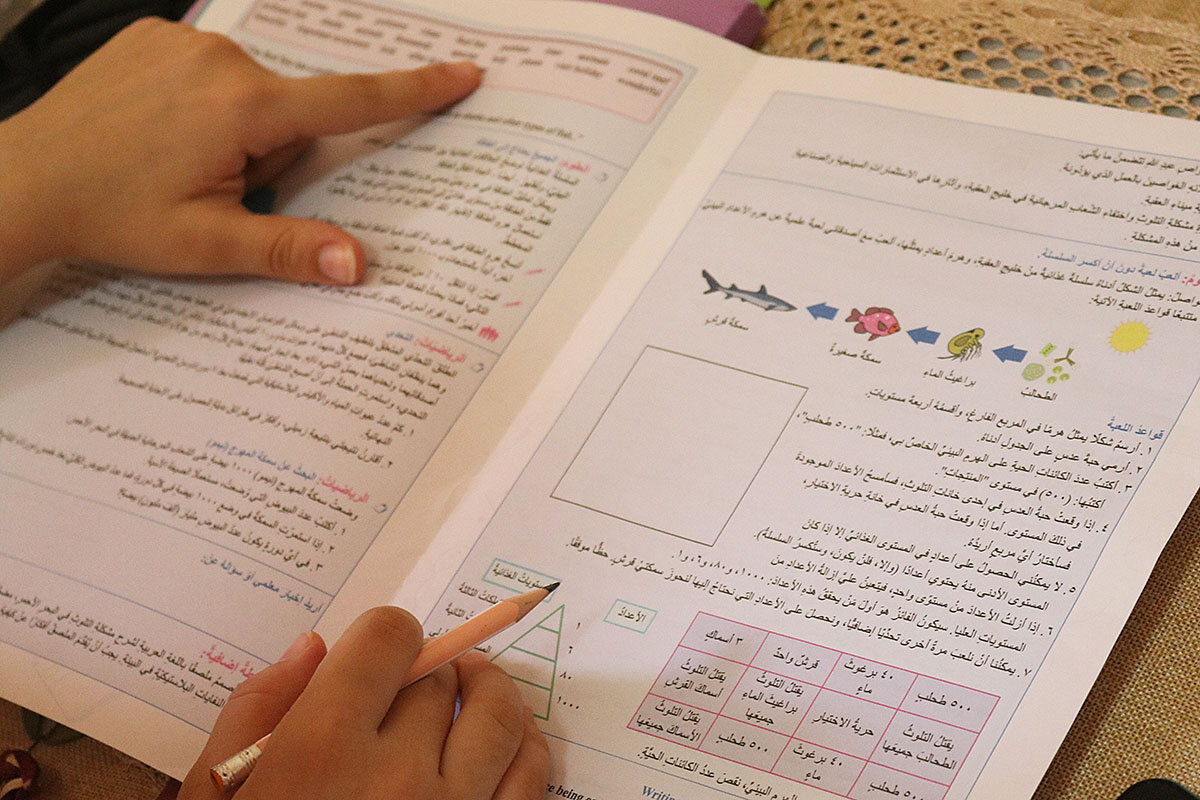Pandemic education: How Jordan’s tech platform bridges divisions
Loading...
| Amman, Jordan
Last March, Jordan switched to distance learning for its 2.5 million K-12 students, using an online learning program developed by a local tech company. Its platform is the most extensive in the Arab world, where many countries have relied on televised lessons during the pandemic.
Since schools remain shut in Jordan, educators are expanding distance learning for the long haul, adding new features that include a chat interface. The platform allows smartphone users to log on without paying for data. It’s been supplemented by activity books and printed coursework distributed weekly at schools.
Why We Wrote This
Educators around the world are grappling with the challenge of remote learning. Jordan has found success with a homegrown tech platform and an emphasis on outreach to disadvantaged students.
Jordan also airs daily lessons on local television channels that are taught by prominent teachers who most students would not otherwise encounter. This has had a leveling effect in an education system that spans deep divisions between urban and rural, and public and private. Some educators are hopeful that this outreach to less-advantaged students can continue post-pandemic.
“There is no way I would have access to these teachers in my life,” says Yazid, a teenager who credits one of these teachers’ televised lessons for helping him to finally crack the physics section in his university placement exam.
Sama Abu Omar knows the drill.
At 8:00 a.m. sharp, the 13-year-old settles into the desk pushed against one wall in her family’s cramped living room which is plastered with her colored motivational notecards. She puts on her headphones, fires up her newly-purchased Chinese-made tablet and begins scribbling notes while watching a video lecture.
A few months ago, Sama didn’t have the internet at home; the tablet cost her two years of savings. “School is my entire life,” she says. Online learning “is the only way to keep the spirit of studying alive. For a while, without it, I was lost.”
Why We Wrote This
Educators around the world are grappling with the challenge of remote learning. Jordan has found success with a homegrown tech platform and an emphasis on outreach to disadvantaged students.
Education has long been a priority in resource-poor Jordan. The country has near universal access to education in grades one through 12, the highest percentage of university-educated women in the region, a 99% literacy rate, and a highly skilled workforce. But its educational resources are spread unevenly: Schools in villages and camps often lack heating and basic materials. Now, Jordan is showing the region a path to bridging learning gaps without deep pockets or vast manpower.
When COVID-19 first began spreading, emptying classrooms around the world, Jordan was one of the first countries in this region to switch in March to distance learning for its 2.5 million K-12 students. Within a week, it had rolled out an online learning program by partnering with a local tech company. Its platform has become the most extensive in the Arab world, where many countries have relied on televised lessons for at-home learning.
Jordanian educators are now working to make blended online learning a permanent pillar of a more open educational system. Schools remain shut here, and it’s unclear when in-class learning can resume, so educators are expanding distance learning for the long haul, adding new features that include a chat interface and teacher-set quizzes and exams. The platform also offers non-core programs such as arts and music.
“We are trying to tailor the experience to each student’s individual learning pathway,” says Mohammad Jaber, founder of Mawdoo3, the Jordanian start-up that created Darsak (Arabic for “your lesson”). “We are going beyond simply making sure learning is not interrupted to re-creating a full classroom experience as much as we can.”
Education officials say the pandemic has helped them to “think differently, be creative, communicate, and collaborate.”
“We have gone from addressing connectivity issues to sustainability, because this is a new learning tool that will benefit our students in the long term after the pandemic,” says Raed Alawiya, an Education Ministry official who is overseeing distance learning.
No phone plan, no problem
When the government tasked Mawdoo3 to design an education platform in a matter of days, its stipulation was for it to be smartphone friendly and to use White Space, a technology that allows phone users to access the internet without the need for data or even a phone plan.
Crucially, Jordanian officials recorded and broadcast daily lessons on local television channels for families with no or limited devices. Each day prominent teachers and experts broadcast a lesson for each grade in the four core subjects: math, science, English, and Arabic.
The data-free access to remote classes was a godsend for many families like Sama’s, who would otherwise use up their monthly phone data package within days.
The benefits of this revamped online platform were unevenly distributed. Prior to COVID-19, 16% of students in Jordan reported not having internet access at home; one-third didn’t have a computer for schoolwork, according to the World Bank. Around 1 in 6 students never logged into Darsak during the spring semester, according to the Education Ministry.
The government is using log-in data to improve access for all students by using foreign funding to provide free devices and boost network connectivity. This has led to higher log-in rates: 70 million in September, compared to 20 million over the spring semester.
Samer Bashir, 11, and his family live in a village outside the southern town of Karak with an unreliable internet connection. COVID-19 lockdowns in the spring and summer prevented them from traveling to relatives’ homes with better connections. Today, they drive to a nearby village each early afternoon so that Samer can upload his homework.
“I never thought my son’s future would depend on a Wi-Fi signal,” says Abu Mohammed, Samer’s father.
Free-to-air lessons
With free internet access and TV broadcasts, students are accessing the same material and lessons as their peers in affluent private schools who were used to being taught by the country’s top teachers. Now those teachers are on air and online, free to watch.
As in many countries, Jordan’s education system features wide disparities in school facilities, resources, and class sizes between those in rich and poor urban districts, and between cities and remote villages, desert settlements, and Syrian and Palestinian refugee camps.
Saddam Dababseh, a 4th-grade science teacher at a West Amman public school, is one of dozens of educators who teaches his own students virtually while also recording lessons for television and online.
“I have learned to go at a deliberate pace and make the material accessible for students of different abilities and pace across the country,” says Mr. Dababseh. “Instead of a single class, I am teaching an entire country and I have to make sure no one gets left behind.”
Students, and even some parents, have latched on to charismatic K-12 teachers renowned in physics, math, and English, and are now following their lessons on YouTube.
“There is no way I would have access to these teachers in my life,” says Yazid, Sama’s 17-year-old brother, who credits one of these teachers’ televised lessons for helping him to finally crack the physics section in his university-placement exam.
Surra Hamadah, a 4th-grade Arabic teacher in a working-class Amman neighborhood and an online instructor, says educators have become more involved in students’ learning outside class. For example, she has helped several students obtain free smartphones and laptops from the Education Ministry.
“Before, when students left the classroom, our contact with them was cut until the next day,” she says. “Now we are connected to help students and their guardians overcome learning obstacles at home.”
Printed coursework closes a gap
Jordan’s distance learning has relied on videotaped lectures that aren’t always that engaging and can be hard for students with reading or listening comprehension difficulties to absorb.
In order to reach students who struggle to engage with the Darsak platform, UNICEF and Jordanian educators have developed Learning Bridges, supplemental activity books and printed coursework distributed weekly at schools that provide an interactive experience for homebound students.
“We needed to find ways to engage students who cannot connect to Darsak or weren’t engaged by Darsak,” says Gemma Wilson-Clark, chief of education at UNICEF Jordan. “Because, let’s be honest, recording a lecture for a student is not always going to excite an 11-year-old.”
Combining math, biology, reading comprehension, English, and Arabic, the extra materials include activities and puzzles. For students with access to smartphones, there are QR codes that open to a portal with videos, tips, graphics, and audio instructions for the week’s lesson.
“Having a piece of paper in between my hands allows me to take it to my parents and ask them questions, or take notes in the margins,” Sama says as she holds up her Learning Bridges workbook.
“I like having resources and videos, but I also miss the classroom,” she says. “I hope after the virus we can have both.”









